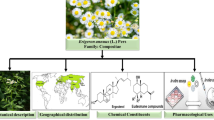Abstract
Annona muricata L., Annonaceae, is extensively used in Mexican traditional medicine for the treatment of gastrointestinal disorders, diabetes mellitus, and as antitumor. The ethanol extract of the leaves from A. muricata was suspended in 10% ethanol water and fractionated by organic solvent extraction with chloroform. The chloroform and aqueous residual fractions were tested for antiprotozoal, antipropulsive, antihyperglycemic, and antilymphoma activities, as well as brine shrimp lethality. While for the antiprotozoal, antilymphoma, and antihiperglycemic activities as well as brine shrimp lethality the chloroform fraction was the most active, the aqueous residual fraction provided better result for the antipropulsive activity. The aqueous residual and chloroform fractions were purified by chromatographic methods to give rutin, nicotinflorin, narcissin, and cis-reticulatacin, as well as β-sitosterol.

Graphical abstract
Similar content being viewed by others
References
Abdul-Wahab SM, Jantan I, MDA H, Arshad L (2018) Exploring the leaves of Annona muricata L. as a source of potential anti-inflammatory and anticancer agents. Front Pharmacol. https://doi.org/10.3389/fphar.2018.00661
ADA (2015) Standards of medical care in diabetes-2015, American Diabetes Association. Diabetes Care 38:1–94
Alali FQ, Liu XX, McLaughlin JL (1999) Annonaceous acetogenins: recent progress. J Nat Prod 62:504–540
Bartelt LA, Sartor RB (2015) Advanced in understanding Giardia: determinants and mechanisms of chronic sequelae. F100Prime Rep. https://doi.org/10.12703/P7-62
Brindis F, González-Trujano ME, González-Andrade M, Aguirre-Hernández E, Villalobos-Molina R (2013) Aqueous extract of Annona macroprophyllata: a potential a-glucosidase inhibitor. Biomed Res Int. https://doi.org/10.1155/2013/591313
Calzada F, Cedillo-Rivera R, Mata R (2001) Antiprotozoal activity of the constituents of Conyza filaginoides. J Nat Prod 64:671–673
Calzada F, Arista R, Pérez H (2010) Effect of plants used in Mexico to treat gastrointestinal disorders on charcoal–gum acacia-induced hyperperistalsis in rats. J Ethnopharmacol 128:49–51
Calzada F, Solares-Pascasio JI, Ordoñez-Razo RM, Velazquez C, Barbosa E, Garcia-Hernandez N, Mendez-Luna D, Correa-Basurto J (2017) Antihyperglycemic activity of the leaves from Annona cherimola miller and rutin on alloxan-induced diabetic rats. Pharm Res 9:1–6
Calzada F, Solares-Pascasio JI, Valdes M, Garcia-Hernandez N, Velazquez C, Ordoñez-Razo RM, Barbosa E (2018) Antilymphoma potential of the ethanol extract and rutin obtained of the leaves from Schinus molle Linn. Pharm Res 10:119–123
Conabio (2019) Annona muricata. Comisión Nacional para el Conocimiento y Uso de la Biodiversidad, www.conabio.gob.mx. accessed 8 April 2019
Debnath A, McKerrow JH (2017) Editorial: Drug development for parasite-induced diarrheal diseases. Front Microbiol 8:577
GBD (2015) Disease and injury incidence and prevalence, collaborators. Global, regional, and national incidence, prevalence, and years lived with disability for 310 diseases and injuries, 1990–2015: a systematic analysis for the Global Burden of Disease Study 2015. Lancet 388:1545–1602
INEGI (2018) Estadística a propósito del día mundial contra el cáncer (4 de febrero) datos nacionales. Available from: www.beta.inegi.org.mx/saladeprensa/aproposito/2018/cancer2018_Nal.pdf. Accessed on 8 April 2019
Meyer BN, Ferrigni NR, Putnam JE, Jacobsen LB, Nichols DJ, MacLaughlin JL (1982) Brine shrimp: a convenient general bioassay for active plant constituents. Planta Med 45:31–34
Murni NS, Qamar UA, Siti ZMS, Alhassan MA, Suganya M, Vikneswari P, Sharifah NASM, Alfi K, Jalifah L (2017) Antioxidant and antidiabetic effects of flavonoids: a structure-activity relationship based study. Biomed Res Int. https://doi.org/10.1155/2017/8386065
Ngueguim TF, Massa ZB, Kouamouo J, Tchuidjang A, Dzeufiet DPD, Kamtchouing P, Dimo T (2014) Antidiabetic and antioxidant effects of Annona muricata (Annonaceae), aqueous extract on streptozotocin-induced diabetic rats. J Ethnopharmacol 151:784–790
Norma Oficial Mexicana (1999) Especificaciones Técnicas Para la Producción, Cuidado y Uso de los Animales de Laboratorio. Available online: http://www.ibt.unam.mx/computo/pdfs/bioterio.NOM-062.pdf. Accessed 13 Aug 2019
OECD/OCDE (2001) Guideline for Testing of Chemicals. Acute Oral Toxicity-acute Toxic Class Method. OECD/OCDE; 2001. p. 1–14. Available from: https://ntp.niehs.nih.gov/iccvam/suppdocs/feddocs/oecd/oecd_gl423.pdf. Accessed 8 April 2019
SSA (2017) Pagina de la Secretaria de Salud. Gobierno de México. Sistema de vigilancia epidemiológica hospitalaria de diabetes tipo 2. Boletín de cierre anual 2017. Available from: http://www.ssa.gob.mx. Accessed 8 April 2019
Vinayagam R, Xu B (2015) Antidiabetic properties of dietary flavonoids: a cellular mechanism review. Nutr Metab. https://doi.org/10.1186/s12986-015-0057-7
Funding
We would like to thank IMSS for the contract grant sponsors: FIS/IMSS/PROT/G17-2/1722 and FIS/IMSS/PROT/G18/1807. We are grateful to the scholarship of IMSS Foundation A. C. given to Dr. Normand Garcia Hernandez.
Author information
Authors and Affiliations
Contributions
LY performed antiprotozoal experiments; EB and JIS performed the phytochemical fractionation of A. muricata; CV and MV performed antipropulsive activity and analysis of the data; NG and EP performed antihyperglycemic activity and analysis of the data; RMaO and VIM performed the antilymphoma and BS tests as well as analysis of the data; FC conceived and supervised and wrote the original draft. All authors reviewed, commented, and approved the final manuscript.
Corresponding authors
Ethics declarations
Protection of human and animal subjects
The authors declare that the procedures followed were in accordance with the regulations of the relevant clinical research ethics committee and with those of the Code of Ethics of the World Medical Association (Declaration of Helsinki).
Right to privacy and informed consent
The authors declare that no patient data appear in this article.
Electronic Supplementary Material
ESM 1
(DOCX 1.70 mb)
Rights and permissions
About this article
Cite this article
Calzada, F., Merlin-Lucas, V.I., Valdes, M. et al. Secondary metabolites and biological properties of Annona muricata. Rev. Bras. Farmacogn. 30, 305–311 (2020). https://doi.org/10.1007/s43450-020-00012-w
Received:
Accepted:
Published:
Issue Date:
DOI: https://doi.org/10.1007/s43450-020-00012-w




